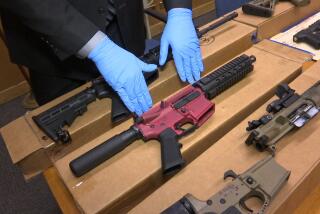Assault Weapons Ban Ends Quietly
- Share via
WASHINGTON — With a 10-year ban on assault weapons due to expire Monday, Congress is about to allow a remarkable reversal: once demonized semiautomatic weapons will again be sold to the public.
Around the nation, manufacturers now prohibited from selling the weapons are competing to reap the most out of their return. Beretta USA Corp. is offering two free large-volume magazines with the purchase of certain guns. ArmaLite Inc. is inviting gun buyers to start placing orders for rifles whose manufacture has been banned for 10 years.
Politicians who had only a few years ago responded to public pressure for controls on such weapons are keeping a cautious distance. President Bush says he supports extending the assault weapons ban, but he has not aggressively worked for legislation to extend it. John F. Kerry, his Democratic presidential opponent, voted this year to extend the ban, but the Massachusetts senator often talks about how he enjoys hunting and supports the 2nd Amendment right to bear arms.
California will still have what is considered one of the nation’s toughest state laws against assault weapons, and bans in several other states also will remain in effect.
But Los Angeles Police Chief William J. Bratton, who was in Washington this week lobbying for the ban’s extension, said that the law’s expiration would be felt “even in a state like California,” because criminals would go out of state to buy assault weapons and high-capacity ammunition magazines and bring them into California.
The 1994 ban, signed by President Clinton, outlawed making and importing 19 types of military-style semiautomatic assault weapons and others with similar features and the manufacture of ammunition magazines containing more than 10 rounds.The law imposed a ban on certain semiautomatic weapons, those that fire one bullet with each squeeze of the trigger but which sponsors of the ban said also allowed for rapid firing. Some pistols as well as rifles were covered by the ban.
The federal ban was a major achievement of Sen. Dianne Feinstein (D-Calif.), who pushed for it after a series of shootings, including a 1993 rampage in a San Francisco office building that left eight people dead and six wounded. The attacker was armed with a .45-caliber Colt semiautomatic pistol and two 9-millimeter TEC-9 Luger semiautomatics. The sale of newly manufactured versions of these weapons was banned by the 1994 law, although those made before Sept. 13, 1994, could still be bought and sold.
Rep. Jack Brooks (D-Texas), who at the time was chairman of the House Judiciary Committee and waged an unsuccessful campaign to defeat the weapon ban, said then: “The people who hate guns are in the majority right now.”
They apparently are not anymore. The ban fell to intense lobbying by the National Rifle Assn. and to fears among Democrats that gun-control advocacy was draining support from rural voters. Although polls indicate that Americans support the assault weapon ban, many Democrats believe that Al Gore’s championing of gun control cost him the presidency in the tight 2000 race against George W. Bush.
The NRA contends that a decade of restricting semiautomatic weapons has done nothing to reduce crime -- and that removing the restrictions would do nothing to increase it.
“These guns were rarely used in crime before the ban. They were rarely used in crime during the ban. And, it’s safe to say they will rarely be used in crime after the ban,” said Chris W. Cox, the NRA’s chief lobbyist.
Feinstein this week blamed “the powerful, selfish NRA and its brutal lobbying tactics” for making the assault weapon ban “one more victim.” But she vowed: “I do not intend to give up. Next year ... we will come back and back and back.”
The gun makers are already coming back.
ArmaLite’s invitation to gun buyers for orders for long-banned rifles promises “delivery immediately upon expiration of the current law.”
Mark A. Westrom, president of Illinois-based ArmaLite, said, “There is a slight increase in interest, but not as much as even I expected,” he said.
At Taurus, a Florida gun maker, executives are making plans to begin manufacturing ammunition magazines that hold up to 17 rounds.
Keeva Segal, Taurus’ marketing manager, said he expected some “pent-up demand” for previously banned items. “But I don’t think it will be people lined up at the door,” he said.
The 1994 law allowed an estimated 1.5 million assault weapons owned before the ban took effect to remain in private hands and permitted the sale of millions of large-capacity ammunition magazines made before the ban took effect. Importing Uzis and AK-47s will remain illegal under an executive order issued by President George H.W. Bush in 1989.
An effort to extend the assault weapons ban won the approval of a majority of senators this year. The assault weapon ban was attached to an NRA-backed measure to shield gun makers and sellers from gun violence lawsuits. The NRA scuttled its bill once renewal of the assault weapon ban was attached.
Sen. Larry E. Craig (R-Idaho), one of the leading opponents of extending the ban, said this year during Senate debate: “Some people stand on the [Senate] floor and say, ‘Oh, you have to stop this because this is the weapon of choice of criminals and they are using it all the time.’ That simply is not true.”
Craig contended that the kinds of weapons covered by the ban were used in only a small percentage of crimes.
Some experts said the loopholes in the ban were so great that small modifications in banned weapons made them legal.
“Nothing of substance will change in the gun industry after the sunset,” said Kristen Rand, legislative director for the Violence Policy Center, a nonprofit organization that advocates gun control. “The difference between the post-ban versions of assault weapons such as the AR-15 and their banned counterparts is entirely trivia.” She added that many assault weapons had been developed since 1994 and fall outside the ban’s restrictions.
Nonetheless, many gun owners are so eager for the measure to die that one group has a website counting down the minutes until the law is wiped from the books. Some gun enthusiasts report that manufacturers are ready to start shipping kits for converting legal guns to pre-ban configurations as early as Tuesday.
Robert Ricker, a former NRA official who consults with gun control groups, foresees a “buying frenzy” for the previously banned military-style weapons and high-capacity magazines.
“Gun owners are thinking, ‘If John Kerry gets elected, chances are that a stiffer ban, or a reauthorization, will eventually happen, so I had better get my assault weapon now.’ ... I think the industry’s mantra is going to be, ‘Buy your wife a high-capacity magazine for Christmas while you can.’ ”
A University of Pennsylvania study conducted this year concluded that gun manufacturers might introduce assault weapon models and large-capacity magazines, “perhaps in substantial numbers.”
“Pre-ban assault weapons may lose value and novelty, prompting some of their owners to sell them in undocumented second-hand markets where they can more easily reach high-risk users, such as criminals, terrorists and other potential mass murderers,” the study warned.
The Consumer Federation of America, which conducted a survey of gun industry plans, predicted that once the law expired, assault weapon manufacturers, “fueled by gun buyer nostalgia,” will “blitz the market” with new models of guns banned under the 1994 law.
Robert J. Spitzer, a political scientist at State University of New York at Cortland and author of “The Politics of Gun Control,” said the lapsing of the ban would lead to greater firepower on the streets as banned weapons returned to circulation. He said large-capacity magazines would become more available.
“These have no hunting or sporting purpose, but are very appealing to criminals because they mean less reloading,” Spitzer said. “Some of the most horrific mass shootings in recent years were halted only when the perpetrators stopped to reload.”
Lawrence G. Keane, senior vice president and general counsel for the National Shooting Sports Foundation, the industry’s trade group, said target shooters would use magazines that could hold more than 10 rounds.
“Reports of police officers needing to fire numerous rounds before being able to stop an assailant prompted the demand for higher-capacity semiautomatic pistols in the 1980s,” said Jeff Reh, Beretta general counsel. “Business owners or homeowners who use a pistol for self-defense have the same need.”
One gun industry executive scoffed at suggestions that once the ban expires, previously banned weapons and ammunition would suddenly be in great demand.
“Our sense is that when we wake up on the morning of the 14th, there is not going to be any monumental change,” said Keane. “The sun-setting of the law is a media event, not a major sales event.”
* (BEGIN TEXT OF INFOBOX)
States and assault weapons bans Even though the 1994 federal assault weapons ban is scheduled to expire next week, seven states have their own restrictions. These state laws vary in what weapons are banned and some, including California, are more restrictive than the federal act.
How California compares to the federal ban:
Restriction California Federal Models, weapon types banned 75 19 Other restrictions Department of None Justice may inspect storage Penalties (for manufacture/ possession/transfer) Up to eight Up to five years prison years prison
Source: Legal Community Against Violence, Brady Campaign to Prevent Gun Violence Tom Reinken
More to Read
Sign up for Essential California
The most important California stories and recommendations in your inbox every morning.
You may occasionally receive promotional content from the Los Angeles Times.











